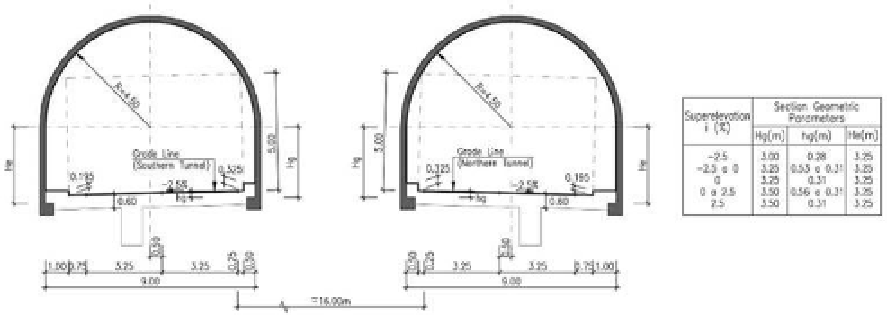Environmental Engineering Reference
In-Depth Information
in the lay-by sections, 6 m length rock bolts were
adopted with a 1.5 m × 2m mesh and a 15 to 30 cm
layer of shotcrete. The excavation and application
of the primary lining were mainly carried out in
full section or in a partial section with a lower and
an upper half.
secondary lining was generally comprised of rein-
forced concrete in a layer varying between 0.25 m in
the ZG1 zone to 0.4 to 0.5 m in the ZG4 zone.
all the tunnels have internal drainage and
impermeabilization systems, the latter comprising
a PVc geo-membranes.
During the execution of the tunnels the rate of
excavation and application of the primary lining
was of the order of 5 m/day in the ZG2 geotechni-
cal zone and 2 m/day in the ZG3 geotechnical zone.
The rate of concreting of the secondary lining with
a metallic frame-work was of around 10 m/day.
next, the most relevant characteristics of the
caniçal Double Tunnel are presented. as a result
of the experience acquired by the authors during
the design and technical assistance phases of vari-
ous projects, it is considered that this is one of the
most representative and emblematic tunnels con-
structed along the Machico-caniçal expressway
and whose location is indicated in Figure 1.
and 3.65% in the southern gallery, from level 70
on the Machico side and up to level 140 on the
caniçal side, comprising the largest double tunnel
in Portugal on the date it was completed. Maxi-
mum covering rises up to 300 m and on average
totals 140 m.
The current transverse cross-section of each gal-
lery, with a working width between walls of 9.0 m and
a maximum height of 7.75 m, ensures a minimum
clearance of 5.0 m and construction of a transverse
roadway profile comprised of a two-lane traffic car-
riageway, an outer hard shoulder of 0.75 m in width
and an inner hard shoulder of 0.25 m in width plus
two sidewalks, an outer of 1.0 m and inner of 0.50 m
at the western end of its stretch, in order to ena-
ble construction of an additional traffic lane which
comprises the exit and entry lanes to the caniçal
road junction, the tunnel galleries have a widened
section whose working width between walls at the
start of the stretch varies from 9.0 m to 12.25 m
and a constant 12.25 m at the end of the stretch,
hence accommodating 3 traffic lanes of 3.25 m.
Given its large extension, 3 emergency park-
ing lay-bys have been constructed in each gallery,
1 connecting gallery between the two central lay-
reverse in the event of an accident and 8 pedes-
trian evacuation galleries. The emergency parking
lay-bys have a transverse cross-section of 12.0 m
in working width, also ensuring a minimum clear-
ance of 5.0 m, and an extension of 16.0 m and
32.0 m, for light vehicles and light/heavy vehicles,
respectively.
From west to east the tunnel crosses two of the
oldest volcanic formations on Madeira island. on
the Machico side, corresponding to the western por-
tal, the tunnel crosses the Mio-Plicoenic volcanic
complex (β
1
); on the caniçal side, where the eastern
portal is constructed, the tunnel crosses the Post-
Miocenic volcanic complex (β
2
) (Baião et al. 2003).
5
caniÇal DoUBle TUnnel
it will now be presented the most relevant char-
acteristics of the caniçal Double Tunnel which
figures as the most representative and emblem-
atic
constructed
along
the
Machico-caniçal
expressway.
The caniçal Double Tunnel is part of the
Machico/caniçal expressway between km 2 + 518
and km 3 + 700 in an east/west direction.
The tunnel comprises two galleries 15 m apart
in a straight direction with 2100 m long and a con-
stant inclination of 3.5% in the northern gallery
Figure 4.
Transverse type cross-section of tunnel galleries.















